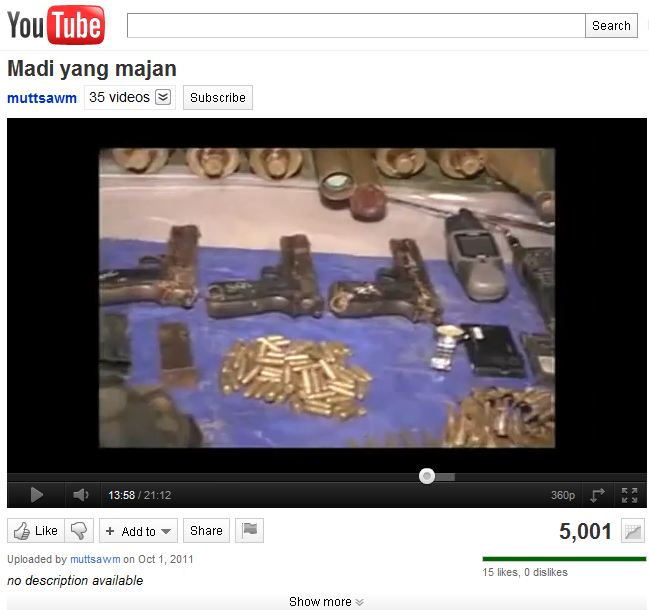Today there is news that yet another Kachin Independence Army (KIA) assault has inflicted significant losses on a Burmese army (tatmadaw) unit. For previous commentary on related issues please see these two New Mandala posts.
This time the attack occured near Sumprabum in northern Kachin State. This is a relatively off-the-beaten-path area; indeed as far as I know very few foreigners have been to Sumprabum, or its neighbourhood, in recent decades. It is remote and rugged terrain.
For that reason, among others, one element of the post-assault report caught my attention: “[t]he KIA seized one soldier, 3 guns, 3 Kenwood R/T, one wireless transmitter and over 1,000 bullets after the fighting”.
I am especially interested in the Burmese soldier who was captured.
Those New Mandala readers who have watched this footage (warning: graphic images) showing the aftermath of an earlier KIA ambush in northern Burma will remember the eyes of the captured tatmadaw troops. They have a haunted look. Face-to-face with their enemy, and shattered by the tenacity of the KIA’s guerrilla tactics, they are worried, no doubt, about what happens next. Calming words from the KIA officer are just the start of what is, I assume, a very difficult process.
But it is so unusual that footage of captured soldiers is ever broadcast that I think it is important that we pay especially close attention to these cases. Before YouTube I can’t imagine that such footage was ever widely available. So we must also ask: what happens next?
In one widely reported case we know that the:
KIA detained two officers and one Burmese soldier on June 8, who intruded into their area of control with weapons but later released them given the request from the Northern military commander of the Burmese Army. The Kachin armed group said they treat prisoners of war well in accordance with the international law and released them with their weapons.
At the same time we heard that:
The KIA, which is currently engaged in heavy fighting with Burmese troops in the country’s north, says the Burmese army may have violated international law on prisoners of war by executing Lance Corporal Cham Yein. The body was returned on 9 June after the KIA handed over two government soldiers accused of spying.
There is, in international law, no ambiguity about the appropriate treatment of prisoners. The “Geneva Convention relative to the Treatment of Prisoners of War” states, in Article 13, that:
Prisoners of war must at all times be humanely treated. Any unlawful act or omission by the Detaining Power causing death or seriously endangering the health of a prisoner of war in its custody is prohibited, and will be regarded as a serious breach of the present Convention. In particular, no prisoner of war may be subjected to physical mutilation or to medical or scientific experiments of any kind which are not justified by the medical, dental or hospital treatment of the prisoner concerned and carried out in his interest.
Likewise, prisoners of war must at all times be protected, particularly against acts of violence or intimidation and against insults and public curiosity.
Measures of reprisal against prisoners of war are prohibited.
In Article 17 there is the classic statement about the basic information that prisoners should provide in terms of “name, rank and serial number”:
Every prisoner of war, when questioned on the subject, is bound to give only his surname, first names and rank, date of birth, and army, regimental, personal or serial number, or failing this, equivalent information.
Everything else is considered out-of-bounds. It is an unforeseen quirk of technology and history that it is now possible to watch the aftermath of a guerrilla ambush in northern Burma and witness the first interactions with captured troops. It is telling that we can see the faces and hear the voices of the tatmadaw soldiers taken prisoner. What happens next? The KIA has previously reassured observers that they are abiding by international law regarding the treatment of prisoners of war.
The treatment of prisoners under such circumstances is always a very sensitive subject but it is also an unambiguous one. Given the intensity of the ongoing fighting in the Kachin State we need to question what the KIA is doing with its Burmese prisoners, such as the soldier taken in Sumprabum this week. And, just as importantly, there needs to be clarity on exactly what the tatmadaw does with KIA prisoners. Everyone needs to answer the same question: what happens next?
Finally, I am somewhat uncomfortable about this footage of prisoners being broadcast at all. While it may appear an esoteric concern in the context of the ongoing and serious fighting in the Kachin State I do wonder whether this YouTube video constitutes “public curiosity” under Article 13 quoted above. For those New Mandala readers that are interested in following up this issue the guidance from the British government is an excellent place to start. Now that the video is available we should certainly treat it sensitively and with great discretion.
There are rights and wrongs that must be considered, even in war.
 Facebook
Facebook  Twitter
Twitter  Soundcloud
Soundcloud  Youtube
Youtube  Rss
Rss 